|

Take a Luxury Train to See America
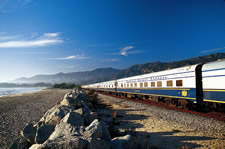 |
|
American
Orient Express
on the Pacific Coast
photo: courtesy of AOE |
Think
cruise ship. On
land.
On
shining rails that crisscross the continent affording
scenes of snow-capped mountains, deep-forested canyons
threaded with glinting rivers. Or intimate close-ups of
crops in rows and old barns, county-seat courthouse squares
and barbecue backyards of city suburbs. And the thrumming
heart of great cities.
So
think cruise train. And, like cruise ships with ports
of call featuring guided land tours of historic sights
and scenic wonders. And shopping time for those of us
thus driven.
Think retro luxury recalling the passenger rail heyday
when sleek Streamliners with evocative names like 20th
Century Limited, Santa Fe Super Chief, Burlington Zephyr
were the preferred mode of Point A-to-B-ing.
Dinner
in the dinah, nothing could be finah….
Think meticulously restored rail cars with interiors of
polished mahogany inlaid with lighter woods. A domed car,
a club car with baby grand piano and sink-into armchairs,
a boat-tailed observation car with comfortable, clubby
seating. Bars of course. Dining cars aglow with lustrous
brass, shining silver on snowy napery. Fresh flowers.
Gleaming crystal. Signature china in royal blue, cream
and gold (the train's exterior color scheme.) Capable,
attentive service. Superior meals of inventive preparation
with the soul of a chef in evidence. What wine tonight?
| During
the day as you pass through the idle dining cars you
might catch a glimpse of the intense young chef and
cohorts rapt in planning sessions. They treat their
restaurant on rails as if it were a side-street eatery
in the city on the brink of discovery. |
Lucius
Beebe never had it better in his private rail car.
Think this and more and you've thought up the American
Orient Express.
American
Orient Express (hereafter AOE) in its present manifestation
is a relatively new (1997) and certainly innovative approach
to travel which allows passengers to sample the elegance
of rail travel as it was half a century ago while experiencing
the country in a manner denied by high-flying jets and
high-speed Interstates.
It is nostalgia resonating from
past to present building new memories for the future.
It is an elegant, pleasant and provocative way to get
up close and personal with the marvels of the continent,
both natural and historic.
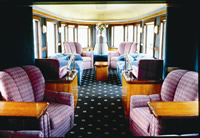 |
Aboard
the AOE
photo: courtesy of AOE |
The
vehicle for this experience is a quarter mile of vintage
private train, lovingly (and expensively) renovated. The
trains (there are now two full sets on separate journeys)
ply rail routes carefully chosen to make the most of astounding
scenery with schedules laid out to take advantage of daylight
hours and peak seasons. For instance on the "Antebellum
South" itinerary which I took in early April from
New Orleans to Washington D.C. fragile dogwood caught
the sun in the brown-limbed woods. Azaleas were still
bright. Spring hazed the hills with its fragile new green
and in the nation's capital the cherry blossoms were at
their delicate best. Talk about timing.
Another
AOE route makes an autumn leaf-peaking pilgrimage through
the maple brightness of New England, upstate New York
and Quebec. With AOE it's not the getting there that counts
it's the being there at the right time. (See "Itineraries"
below.)
The
AOE tours are train-based, but scarcely confined to the
train. The train is parked on sidings or at stations with
passengers disembarking to widen the tour via motorcoach,
van, horse-drawn carriage or shanks mare, whichever is
appropriate for closer encounters with national parks,
cities, mansions, public buildings, plantations, cemeteries
and/or shopping streets. Oh yes, boats are an option on
the itineraries including Glacier National Park.
On
my Antebellum South trip I found the provided guides informative
and entertaining. In New Orleans, Anne Lenhard, a retired
kindergarten teacher, explained in a voice as sonorous
as a church bell why she is called "Queen of the
Cemeteries."
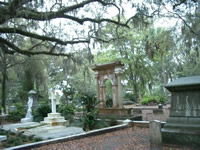 |
Savannah
Cemetery
photo: Denise McCluggage |
To
anyone mildly acquainted with southern writers it was
no surprise to find cemeteries twining throughout the
itinerary. Besides New Orleans's unique aboveground mausoleums
there was the Bonaventure Cemetery in Savannah featured
in the book (and movie) "Midnight in the Garden of
Good and Evil." One can say with confidence that
death is alive and well in the Southland.
On
one bright day we clip-clopped through the delightful
streets of Charleston, SC and the rows of handsome houses.
The sun was beaming but the air bore unseasonable chill
making the lap robes in the wagon behind the big gray
(breathing smoke plumes) more than welcome. Our lady teamster,
dressed in a natty version of a confederate army uniform,
was truly witty, charming and knowledgeable. Good hands
on the reins, too.
After
the heyday of passenger trains in the '40s and '50s, ridership
plunged steeply (82% in a decade) yet trains still maintained
a romantic hold on the souls of travelers. Yes, the convenience
of the family sedan on Eisenhower's burgeoning Interstates
and the speed of transcontinental airlines drained away
business, but the pleasures of a gently swaying rail car,
the countryside sliding by the window, the plaintive trailing
of a train whistle still tugged at the imagination of
the traveler. The late Ted Rose, a superior painter of
trains and their environs wrote: "Railroads are to
the American landscape what the blues are to American
music: a connective underlayment - original, intact and
human scale."
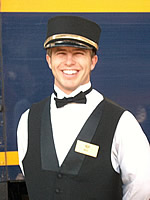 |
Mike,
a porter on the AOE
photo: Denise McCluggage |
Thus
boarding the AOE train in New Orleans (and probably at
every embarkation city) passengers greeted by the uniformed
staff and assisted aboard by the porters are all wearing
the same anticipatory smile. Maybe they are recalling
a rail experience of their youth; maybe they are train
buffs adding new miles to their life list; maybe they
have never set foot on a train, but just ahead for all
of them lies a unique adventure. And they sense it.
Each
AOE trip begins with an introductory welcome reception
and dinner at the hotel where the first overnight is spent.
Train staff and passengers meet and mix. After breakfast
on the first day is a tour of the embarkation city, lunch
at a special restaurant and then a late afternoon boarding
of the train.
The
Pullman cars bear city names, both European and American
- Berlin, Washington, Savannah, Paris, Montreal, Portland,
Denver. Seattle is the club car with the piano. A professional
tickler of the ivories helps turn the car into a relaxed
and amiable boite every cocktail hour and again after
dinner. Both voices and glasses might be raised. Laughter
and chatter and even some serious conversations. (And
murder - but more about that later.)
Dinner
might be in either Zurich or Chicago (or so the dining
cars are named.) Choose one tonight, another tomorrow.
Or stake out a claim. No set seating assignments.
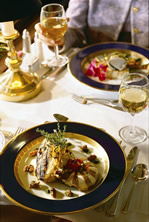 |
Dinner
aboard the AOE
photo: courtesy AOE |
Warm
lamplight spills across the tables, seating for two or
four. Dine where you like with whom you like or alone
with your thoughts or a book. The extended dinner hour
is from 6:00 to 9:00. And, forgive me for being repetitious,
but the meals are consistently a cut above excellent.
Five course dinners with three entrée choices.
Regional touches where possible.
A
glance in the kitchen will reveal frenzied activity in
a tiny space and yet each plate emerges into calm and
order. During the day as you pass through the idle dining
cars you might catch a glimpse of the intense young chef
and cohorts rapt in planning sessions. They treat their
restaurant on rails as if it were a side-street eatery
in the city on the brink of discovery.
Not every day is a travel day. For instance, our train
sat on a siding in Richmond for two nights. One day we
toured that historic capital (of Virginia and of the Confederacy)
and visited a historic plantation. The next day the group
boarded motorcoaches to visit Thomas Jefferson's Monticello
near Charlottesville. Having been to Monticello twice
in the past two years I opted (as anyone can) to stay
onboard the train that day and "get some work done."
Well intended.
However
I lazed about perusing several books on trains (including
one of Ted Rose's paintings) I found in the train library.
I could have moseyed over to the old train station, now
a youth museum, but the great motionless calm of the train
and the cozy privacy of my compartment were the stronger
draws. I do like trains. Moving or still.
Accommodations: About those compartments: space is at a premium in anything
as long and skinny as a train, but the compartments (five
different configurations) put every inch to good use.
Surprising how useful a "closet" with a mere
four inches of hanging space can be.
All
but one of the five compartment styles (the Single Sleeper)
are intended for double occupancy. All have their own
private water closet in a compact little room and a sink
and vanity in the cabin.
The
shower room for occupants of the Single Sleeper and the
basic Vintage Pullman (which makes into a lower and upper
berth) is at the end of the car down the aisle. (Terry
robes are provided.) Schedule your preferred shower time
with the porter who sees that the shower room is cleaned
and squeegeed dry immediately afterward. The Parlor Suite,
Deluxe Suite and the double-size Presidential Suite all
have private shower compartments.
Showering
while the train is moving can be an exercise in agility
but grab bars are plentiful and well placed. Actually,
it’s more fun than anything.
I
was alone in my Vintage Pullman but in imagining a fellow
traveler I didn't envisage any serious crowding problems.
The public cars are rarely more than a car length or two
away so roommates can expand and contract their needed
personal space with a little planning. And the porter
is handy for quick conversion of the bench seat into a
berth or back again.
Stowage could be a problem if you house two clotheshorses
in the same compartment. (Casual dress is always right
though you can show off as much as you like, if you like.)
Besides
that four-inch hanging space there's a large floor-level
drawer under the seat. It swallows a surprising amount.
My luggage was a wheeled duffle bag that, when largely
empty, slipped under the seat next to the drawer. It would
also have fit in the high deep shelf (above the water
closet room) at eye level with the upper berth. That's
where I put my carry-on backpack (computer, camera etc).
But please do note that there's no off-site storage. All
your baggage, empty or full, remains with you so make
sure any bag can be compressed to less than six inches.
Itineraries: Of the eight itineraries most take eight days and seven
nights. The transcontinental trips are 11 days and 10
nights.
Spectacular
scenery that presses in on the domed car seems to be most
admired. It is not by chance that the dome car is named
"Copper Canyon." The route between Tucson AZ
and Copper Canyon in Mexico is perhaps the most popular
offered. The Copper Canyon trip includes airfare between
Chihuahua and Tucson. (Or vice versa depending on the
direction of your chosen tour.)
The
Canadian Rockies are equally spectacular and The Grand
Trans-Canada Rail Journey between Vancouver and Montreal
(or reverse) gets right in the midst of them and schedules
a stop at Jasper National Park.
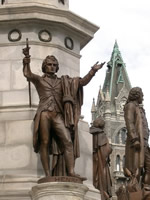 |
Patrick
Henry in Richmond, Va.
photo: Denise McCluggage |
Several
itineraries grow equally intimate with the American Rockies.
National Parks of the West is one, the Great Northwest
and Rockies is another.
New
for 2004 will be The American Southwest from San Antonio
to Los Angeles with stops in Santa Fe, Sedona and Phoenix.
Then,
new this year, is the coastal between Los Angeles to Seattle
(with guided tours of the Hearst Castle at San Simeon,
Muir Woods, Napa Valley wine country, Multnomah Falls
and Portland.)
And,
note this, there's still time to make the last run of
the Great Transcontinental Rail Journey. That route will
be discontinued after 2003. Its last trip, beginning in
Washington D.C. October 28 and ending in Los Angeles November
7, does Charleston, Savannah, New Orleans, Santa Fe and
the Grand Canyon. How cool is that?
I
earlier mentioned the autumn trip through the Northeast
and the Antebellum South trip that I took. Get a brochure
(see below) and dream.
History: AOE, though not connected with the Orient Express in Europe,
can trace its origins to nostalgia for that exotic rail
route, the site of the Agatha Christie mystery "Murder
on the Orient Express." The idea of restored vintage
rail cars to commemorate the golden age of train travel
felt its way through several concepts. The old cars were
methodically located and meticulously restored to a high
standard under the direction of William F. and Melissa
Spann of Florida's Bay Point Yacht and Country Club.
The
cars began their new life as part of AMTRAK service between
Washington DC and Chicago. The idea was that business
people would appreciate luxury, ease and time in their
workaday travel. It seems most preferred crowding, haste
and getting there fast. The posh train service lasted
about a year.
Increasingly
it became clear that tourists were better appreciators
of vintage luxury than business folk. Through experimentation
and a number of owners, (now Henry Hillman of the Pittsburgh
steel Hillmans) the cruise train concept with ports of
call for off-rail expeditions evolved and the AOE found
its identity. That evolution is ongoing with Mr. Hillman
as president and CEO. New itineraries are researched and
added as return clientele push for ever more choices.
Themes
and entertainment: The various itineraries might have
themes attached to them. Common to the Antebellum South
trip are the themes "Civil War" and "Jazz,"
both particularly apt for the route. Lecturers (or music)
appropriate to the theme are scheduled for the club car
while underway and off-train excursions are aligned with
the theme.
My
Antebellum South trip saw the inauguration of a new theme:
"Murder on the American Orient Express."
Keith
and Margo's Murder Mystery USA out of Los Angeles are
experienced in staging interactive murder mystery programs
but this was the first they would do on a train. They
adapt existing scripts. Actors are imbedded in the group
traveling as regular tourists.
As
passengers boarded the train, they passed by a "dead"
body and a "detective" investigating the crime.
The game was on. As the trip progressed clues were discovered
(and then kept on file for the game-players to study at
will.)
An
intended by-product of the mystery game is to stir the
soup and set passengers talking to each other, asking
questions and getting acquainted. That seemed to work
as planned. The train capacity is 100 passengers though
the April Antebellum tour had 60 aboard.
Some
passengers said they had taken that particular train trip
because of the murder mystery; some in spite of it. Both
groups managed beautifully. Those who were involved in
the day-to-day process of murder most foul were enrapt;
those who chose not to participate weren't in the least
bothered by the background hum of clues and motives. Coexistence
was easy and amiable.
It
could certainly be said that for both groups the first
"Murder on the American Orient Express" was
a success. Count on similar bloodletting and detecting
occurring on other itineraries.
Cost: Given the evident expense involved in the
AOE rail cars, their condition and upkeep; the quality
of the dining experience, and the top-of-the-line off-train
tours one would expect to pay well for the adventure.
One does. This is not budget travel, but then the value
quotient is high.
Sample
costs: Two sharing a Vintage Pullman compartment on
the Pacific Coast Explorer itinerary (eight days, seven
nights) would pay $2,890 each. A Presidential Suite is
$4,990 for each resident. On the Mexico and Copper Canyon
itinerary a Deluxe Suite cost $5,890 each but that includes
the charter flight between Chihuahua and Tucson.
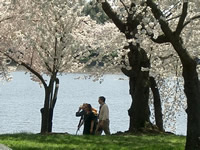 |
Tourists
enjoy cherry blossoms in Washington, D.C. -- just
one stop on the Antebellum South AOE trip.
photo: Denise McCluggage |
Much,
except getting to the train and home again, bar tabs in
the club car and shopping sprees, is included. Tips for
the train staff (about $15 a day) is not. House wines
at dinner are included; ordering from the wine list is
not.
Discounts
($300) are allowed for booking six months in advance.
And return travelers, of which there are a growing number
(I hope to be among them) are granted similar savings
as automatic members of the Golden Rail Club. They also
get 10% off on-train purchases including liquor and boutique
purchases.
More
information: Call this toll free number to request
a brochure: 877-854-3545. Or write: American Orient Express,
5100 Main Street, Suite 300, Downers Grove, IL 60615-4651.
The
website (www.americanorientexpress.com)
is helpfully complete but annoyingly spells "Santa
Fe" as "Sante Fe" much of the time. But
then computer people are not notably spelling mindful
for some reason.
Tour
rates and dates, booking information and details on discounts
can all be found on the website. Or check with your travel
agent.
Closing thoughts: Though children eight years old
and above are accepted, I doubt that an AOE trip is an
ideal choice for them. None was on the trip I was on.
The lounge cars are designed for adult activities whether
that be playing cards, reading, drinking, or conversation.
Kids would have to be inordinately capable of self-entertainment
and exhibit a unique talent for not being noticed to fit
them in this scenario. In short they would likely be bored
out of their tiny minds.
Then
again train travel is not ideal for the lame and halt
either. Train passageways are 23 inches wide, compartment
doors 18 inches. Negotiating one's way on a swaying train
is not recommended for anyone needing assistance walking.
Though I am told this has not discouraged many who are
determined to see the wonders of the world that are visible
only from a train.
Suggestion: Grown children of parents who are on the verge of a notable
anniversary would do well to look into an AOE trip as
a memorable gift. Get all the sibs together and select
the perfect itinerary. Surprise, surprise! Train travel
is remarkably hassle free, takes place on solid ground
over known pathways and is both something new and something
old all at once. It's different. And cell phones usually
work so keeping tabs is easy.
Think
train cruise.
AMERICAN
ORIENT EXPRESS NOW
OFFERING ONLINE BOOKING
Travelers
interested in a deluxe trip onboard America's premier,
private train, American Orient Express (AOE), can
now book their rail vacations with ease, online
at .
By
visiting the AOE website, passengers are able to
plan their trip from start to finish. Online
booking gives customers the ability to select itineraries
and travel dates, as well as to view and choose
cabin categories all with the click of their mouse.
A deposit is required, with an amount due at time
of 7 days. Final payment is due within 60 days. Check with the AOE website for specific fees. |
|